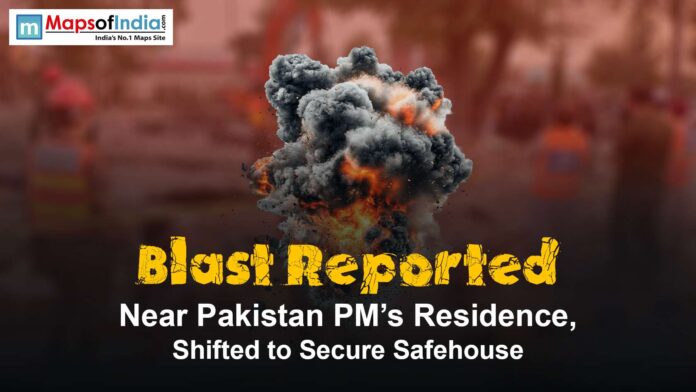Blast Reported Near Pakistan PM’s Residence, Shifted to Secure Safehouse
Meta Description: A powerful explosion occurred near Pakistani Prime Minister Shehbaz Sharif’s residence in Islamabad on May 8, 2025. As tensions rise with India, the PM was moved to a secure safehouse. Full details and implications here.
Introduction
In a chilling development that has shocked South Asia and the world, a blast was reported near Pakistan Prime Minister Shehbaz Sharif’s residence in Islamabad on May 8, 2025. The explosion, occurring amidst growing tensions between India and Pakistan, has raised alarm bells in diplomatic circles and triggered nationwide security measures in Pakistan. The Prime Minister was reportedly shifted to a secure safehouse soon after the incident, signaling the seriousness of the threat.
Explosion Near PM’s Residence
The blast occurred approximately 20 kilometers from the official residence of Prime Minister Shehbaz Sharif in Islamabad during the early hours of May 8. The loud explosion shook nearby areas, causing windows to shatter and creating panic among residents. Emergency services rushed to the scene, but as of now, there have been no confirmed casualties or official statements on the target or cause.
Sources say the Prime Minister was quickly taken to a very secure location after the explosion. Since the blast happened in a heavily guarded area, some believe it may have been done on purpose to create fear or send a political message.
India-Pakistan Tensions at Boiling Point
The explosion came just hours after India launched ‘Operation Sindoor’, a series of air and missile strikes targeting alleged terror infrastructure in Pakistan-administered Kashmir and deep inside Pakistan itself, including key cities such as Lahore, Sialkot, and Karachi.
India claims the strikes were a direct response to the Pahalgam terror attack on April 22, which killed 27 civilians, most of them Hindu pilgrims. The Resistance Front (TRF) took responsibility for the attack, and India has accused Pakistan’s intelligence agency of backing the group—a claim Islamabad denies.
The Islamabad explosion near PM’s residence is now being examined within this broader context, fueling speculation that it may have been a targeted military or strategic strike.
Was the PM the Target?
While India has not acknowledged any involvement in the explosion near the Pakistani Prime Minister’s residence, the incident’s proximity to the country’s leadership compound has raised eyebrows. Some analysts believe the blast may have been a calculated warning shot, designed to display India’s long-range precision capabilities and assert strategic dominance.
However, it is also possible that the explosion was the result of Pakistan’s own internal instability, a mishap in ammunition storage, or even a false flag operation intended to shift the global narrative.
Regardless, the fact that Prime Minister Sharif was moved to a safehouse underlines the severity with which the Pakistani government is treating the threat.
Operation Sindoor: India’s Offensive Military Strategy
Launched on May 7, Operation Sindoor involved Indian Rafale jets armed with SCALP missiles and AASM Hammer bombs. According to India’s Defense Ministry, these strikes were measured, precise, and designed to neutralize terrorist infrastructure without civilian casualties.
The military operation was seen as a retaliatory move for the Pahalgam massacre and a strong message to Pakistan that cross-border terrorism would no longer go unanswered.
Some reports suggest Indian missiles may have struck strategic sites in Islamabad’s vicinity, raising the possibility that the May 8 blast was part of these strikes.
Pakistan’s Countermoves: Limited But Aggressive
In response to India’s aerial attacks, Pakistan launched drone and missile strikes on Indian border cities, including Amritsar and Jammu. However, India’s S-400 missile defense systems reportedly neutralized many incoming threats.
Pakistan’s military called India’s actions “unprovoked aggression” and vowed “decisive retaliation.” Yet, the Indian government maintains its position that these operations were preemptive and necessary to ensure national security.
Civilian Safety and Government Measures
Following the explosion near the PM’s residence, the Pakistani government raised its national threat level and activated emergency protocols in all major cities. Evacuation plans were tested, elite military units were deployed across Islamabad, and public gatherings were temporarily banned.
On the Indian side, Operation Abhyaas, a civil defense drill conducted on May 7, involved blackout rehearsals, siren drills, and mass evacuation simulations across 244 districts. These drills are now seen as critical foresight, given the speed at which the conflict escalated.
Indus Waters Treaty Suspended: A Strategic Shift
Another major development worsening the conflict was India’s decision on April 23 to suspend the Indus Waters Treaty, a long-standing agreement between the two nations governing river sharing. This led to a drastic reduction in the Chenab River’s water flow into Pakistan, triggering fears of drought and food shortages.
Pakistan labeled the move an act of war, while India justified it under national security provisions. This development adds a hydro-political dimension to the growing crisis.
Casualties and Damage Overview
Though the Islamabad explosion’s casualty count remains unverified, the overall toll from the recent clashes is significant:
India: 15 civilians and 2 soldiers killed; 40+ injured
Pakistan: 31 civilians dead, 46+ injured (as per unofficial sources)
Infrastructure: Damage reported in Lahore, Karachi, and Sialkot; energy grids and communication lines disrupted
Global Response: Growing Calls for De-escalation
The international community reacted swiftly to the Islamabad explosion and the broader conflict:
United Nations: Urged immediate de-escalation and dialogue.
United States: Called the situation “extremely dangerous,” with former President Trump offering to mediate.
China and Russia: Expressed concern but refrained from openly condemning either side.
European Union: Issued travel warnings and advised both nations to refrain from further aggression.
The proximity of the explosion to the Pakistani Prime Minister has alarmed global security agencies, increasing fears of an all-out war between two nuclear-armed states.
Economic Impact: Markets Shake Amid Tensions
The geopolitical unrest has had visible effects on financial markets:
The Indian rupee dropped 0.8% against the dollar.
The Sensex and Nifty indices fell sharply amid investor panic.
Oil prices rose slightly due to anticipated supply chain disruptions in South Asia.
Cross-border trade has come to a halt, affecting billions in annual trade volume.
The explosion near Islamabad added fuel to investor anxieties, triggering global market alerts.
Culture and Sports Affected
The Indian Premier League (IPL) was forced to relocate matches due to security concerns.
The Indo-Pak collaborative film “Abir Gulaal” was banned in both countries.
Artists and musicians canceled scheduled performances, citing instability and safety risks.
These events have further strained people-to-people ties, often viewed as a soft diplomatic bridge during tense periods.
Strategic Outlook: What Lies Ahead?
With both sides showing no signs of backing down, the situation remains volatile. The Islamabad blast near the Prime Minister’s residence is not just a localized incident—it symbolizes the depth of hostility between India and Pakistan.
Experts suggest that backchannel diplomacy is urgently needed. Even a minor miscalculation at this point could lead to irreversible consequences, especially given the nuclear capabilities on both sides.
Conclusion
The May 8, 2025, explosion near Pakistan PM Shehbaz Sharif’s residence marks a significant turning point in India-Pakistan relations. While the exact source of the blast remains unconfirmed, its implications are crystal clear: the region stands on the edge of a possible full-scale war.
For now, the global community watches and waits, hoping for wisdom to prevail over warfare.




